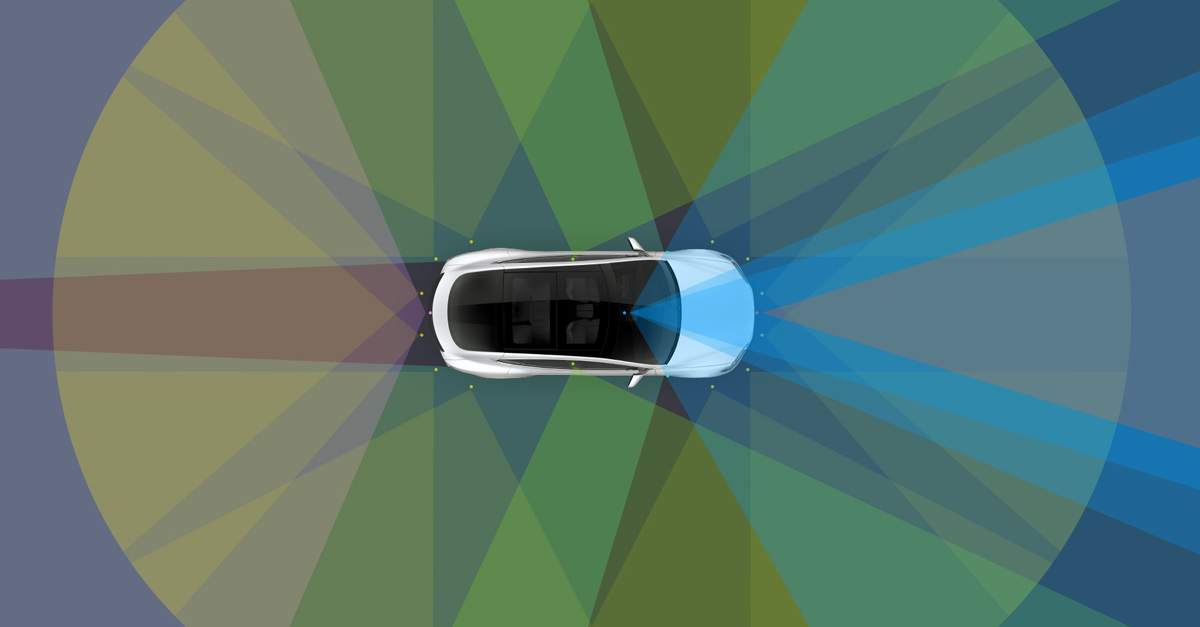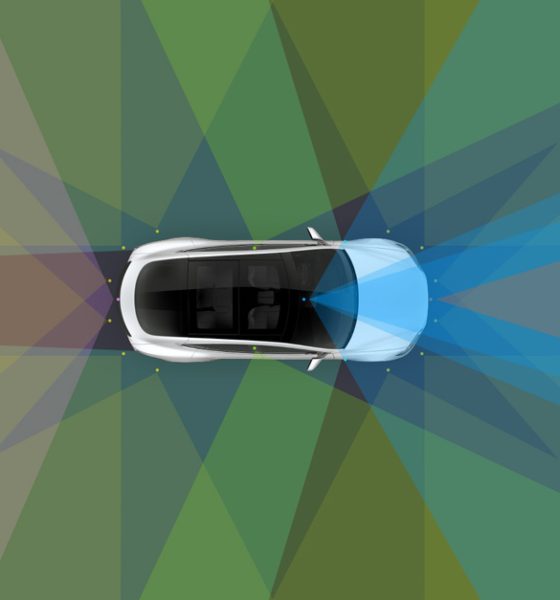Tesla’s Full Self-Driving (FSD) suite is among the most complex and accurate systems on the road, but the company has always focused on constant improvement. Tesla has now filed an application with the Federal Communications Commission (FCC) for a “millimeter-wave radar sensor” for its vehicles.
Tesla’s focus on cameras and sensors has been evident since the beginning of its self-driving journey. With the company having several options to utilize in its quest for autonomy, Elon Musk has always maintained that Tesla would utilize cameras and radar, not LiDAR, for its self-driving projects. Musk once called LiDAR “a fool’s errand” and refused ever to consider the system for Tesla.
Instead, Tesla has used eight external body cameras, twelve ultrasonic sensors, and a front-facing radar to improve the accuracy of its self-driving cars. To make the cars even more predictable and safe, Tesla also uses a Neural Network to gather data and information that learns other drivers’ behavior. The 20 billion miles of real-world data Tesla has gathered over the years contributes to the Neural Net’s development and makes the entire Autopilot and FSD system more accurate as more miles are driven.
Tesla Autopilot’s 4D upgrade could lead to more FSD features
With all of these sensors, cameras, and radars, most would think that Tesla’s FSD suite, which is already showing vast improvements since the FSD Beta rollout in late 2020, just needs more miles and time to improve. But this isn’t the case, because Tesla wants to install a more refined radar sensor in its cars to improve accuracy even further.
Originally obtained and reported by Electrek, the FCC document doesn’t reveal full details on the device because of a confidentiality agreement. This will keep the finer points of the system until July 2021.
The document says that the new radar will operate in a 60 GHz band.
“The equipment under test (EUT) was a Vehicle Millimeter-wave Radar Sensor operating in 60 GHz band (60-64 GHz).”
Ultimately, using a new, more refined, and more accurate sensor will help Tesla develop its self-driving suite even further. Last year, Musk revealed during the Q3 2020 Earnings Call that the company planned to move to a 4-dimensional training program, moving away from its “~2.5D” system that it currently uses. 4D is “essentially video” and would help improve the system’s accuracy.
Musk explains:
“So what we’ve been doing, thus far, has really just been like 2D — mostly 2D, and like I said, well correlated in time. So just hard to convey just how much better a fully 4D system would work — does work. It’s capable of things that if you just look — looking at things as individual pictures as opposed to video — basically, like you could go from like individual pictures to surround video, so it’s fundamental. So the car will seem to have just like a giant improvement.”
The 4D system would be capable of handling different traffic scenarios in a more sophisticated and accurate fashion because video is easier to gain information from than pictures. It will likely work in combination with Tesla’s Dojo supercomputer, which is set to be released late this year.
What do you think? Leave a comment down below. Got a tip? Email us at tips@teslarati.com or reach out to me at joey@teslarati.com.
Tesla Millimeter Sensor Wave Radar by Joey Klender on Scribd

News
Tesla FSD fleet is nearing 7 billion total miles, including 2.5 billion city miles
As can be seen on Tesla’s official FSD webpage, vehicles equipped with the system have now navigated over 6.99 billion miles.

Tesla’s Full Self-Driving (Supervised) fleet is closing in on almost 7 billion total miles driven, as per data posted by the company on its official FSD webpage.
These figures hint at the massive scale of data fueling Tesla’s rapid FSD improvements, which have been quite notable as of late.
FSD mileage milestones
As can be seen on Tesla’s official FSD webpage, vehicles equipped with the system have now navigated over 6.99 billion miles. Tesla owner and avid FSD tester Whole Mars Catalog also shared a screenshot indicating that from the nearly 7 billion miles traveled by the FSD fleet, more than 2.5 billion miles were driven inside cities.
City miles are particularly valuable for complex urban scenarios like unprotected turns, pedestrian interactions, and traffic lights. This is also the difference-maker for FSD, as only complex solutions, such as Waymo’s self-driving taxis, operate similarly on inner-city streets. And even then, incidents such as the San Francisco blackouts have proven challenging for sensor-rich vehicles like Waymos.
Tesla’s data edge
Tesla has a number of advantages in the autonomous vehicle sector, one of which is the size of its fleet and the number of vehicles training FSD on real-world roads. Tesla’s nearly 7 billion FSD miles then allow the company to roll out updates that make its vehicles behave like they are being driven by experienced drivers, even if they are operating on their own.
So notable are Tesla’s improvements to FSD that NVIDIA Director of Robotics Jim Fan, after experiencing FSD v14, noted that the system is the first AI that passes what he described as a “Physical Turing Test.”
“Despite knowing exactly how robot learning works, I still find it magical watching the steering wheel turn by itself. First it feels surreal, next it becomes routine. Then, like the smartphone, taking it away actively hurts. This is how humanity gets rewired and glued to god-like technologies,” Fan wrote in a post on X.
News
Tesla starts showing how FSD will change lives in Europe
Local officials tested the system on narrow country roads and were impressed by FSD’s smooth, human-like driving, with some calling the service a game-changer for everyday life in areas that are far from urban centers.

Tesla has launched Europe’s first public shuttle service using Full Self-Driving (Supervised) in the rural Eifelkreis Bitburg-Prüm region of Germany, demonstrating how the technology can restore independence and mobility for people who struggle with limited transport options.
Local officials tested the system on narrow country roads and were impressed by FSD’s smooth, human-like driving, with some calling the service a game-changer for everyday life in areas that are far from urban centers.
Officials see real impact on rural residents
Arzfeld Mayor Johannes Kuhl and District Administrator Andreas Kruppert personally tested the Tesla shuttle service. This allowed them to see just how well FSD navigated winding lanes and rural roads confidently. Kruppert said, “Autonomous driving sounds like science fiction to many, but we simply see here that it works totally well in rural regions too.” Kuhl, for his part, also noted that FSD “feels like a very experienced driver.”
The pilot complements the area’s “Citizen Bus” program, which provides on-demand rides for elderly residents who can no longer drive themselves. Tesla Europe shared a video of a demonstration of the service, highlighting how FSD gives people their freedom back, even in places where public transport is not as prevalent.
What the Ministry for Economic Affairs and Transport says
Rhineland-Palatinate’s Minister Daniela Schmitt supported the project, praising the collaboration that made this “first of its kind in Europe” possible. As per the ministry, the rural rollout for the service shows FSD’s potential beyond major cities, and it delivers tangible benefits like grocery runs, doctor visits, and social connections for isolated residents.
“Reliable and flexible mobility is especially vital in rural areas. With the launch of a shuttle service using self-driving vehicles (FSD supervised) by Tesla in the Eifelkreis Bitburg-Prüm, an innovative pilot project is now getting underway that complements local community bus services. It is the first project of its kind in Europe.
“The result is a real gain for rural mobility: greater accessibility, more flexibility and tangible benefits for everyday life. A strong signal for innovation, cooperation and future-oriented mobility beyond urban centers,” the ministry wrote in a LinkedIn post.
News
Tesla China quietly posts Robotaxi-related job listing
Tesla China is currently seeking a Low Voltage Electrical Engineer to work on circuit board design for the company’s autonomous vehicles.

Tesla has posted a new job listing in Shanghai explicitly tied to its Robotaxi program, fueling speculation that the company is preparing to launch its dedicated autonomous ride-hailing service in China.
As noted in the listing, Tesla China is currently seeking a Low Voltage Electrical Engineer to work on circuit board design for the company’s autonomous vehicles.
Robotaxi-specific role
The listing, which was shared on social media platform X by industry watcher @tslaming, suggested that Tesla China is looking to fill the role urgently. The job listing itself specifically mentions that the person hired for the role will be working on the Low Voltage Hardware team, which would design the circuit boards that would serve as the nervous system of the Robotaxi.
Key tasks for the role, as indicated in the job listing, include collaboration with PCB layout, firmware, mechanical, program management, and validation teams, among other responsibilities. The role is based in Shanghai.
China Robotaxi launch
China represents a massive potential market for robotaxis, with its dense urban centers and supportive policies in select cities. Tesla has limited permission to roll out FSD in the country, though despite this, its vehicles have been hailed as among the best in the market when it comes to autonomous features. So far, at least, it appears that China supports Tesla’s FSD and Robotaxi rollout.
This was hinted at in November, when Tesla brought the Cybercab to the 8th China International Import Expo (CIIE) in Shanghai, marking the first time that the autonomous two-seater was brought to the Asia-Pacific region. The vehicle, despite not having a release date in China, received a significant amount of interest among the event’s attendees.










